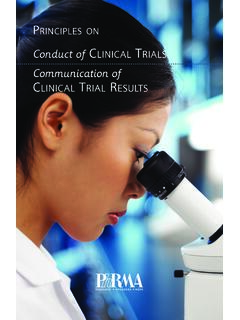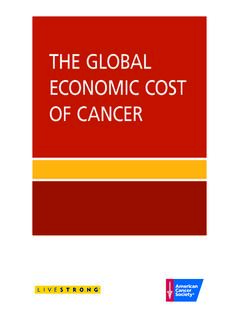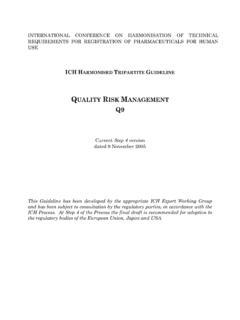Transcription of Follow the Dollar - PhRMA
1 Full colorblackwhiteNovember 2017 Follow the Dollar Understanding How the pharmaceutical Distribution and Payment System Shapes the Prices of Brand Medicinesfull colorblackwhiteTable of ContentsIntroduction 1 From the Factory to the Pharmacy 3 Patient Experience: Understanding Out-of-Pocket Costs 5 The Financial Back-end: Understanding Discounts and Rebates 7 Janet, Scott, and Diane: How the System Works for Patients 10 The Evolution of the pharmaceutical Market 16 References 18full colorblackwhiteIntroductionOver the past year, increased media and policymaker focus on the price of medicines has led to anger and frustration targeted at pharmaceutical manufacturers, pharmacy benefit managers (PBMs), and health plans.
2 Drug pricing is a complex and often confusing issue, shaped by a pharmaceutical distribution and payment system that involves multiple transactions among numerous stakeholders. A better understanding of the players involved in the pharmaceutical supply chain, and the role each plays in determining what patients utlimately pay for their prescription medicines, can help consumers and policymakers find answers to their questions and concerns about cost and access to medicines. While there has been significant public discussion about the prices of prescription medicines, it is rarely clear what price is being discussed.
3 As this paper shows, there is no one price for a medicine, as prices paid by wholesalers, pharmacies, PBMs, and health plan sponsors all vary and are determined by negotiations between stakeholders, each with varying degrees of negotiating power. For example, large PBMs that negotiate on behalf of health plan sponsors and manage benefits for covering tens of millions of patients are able to leverage their market power to obtain substantial discounts and rebates on brand medicines. As the supply chain has consolidated and competition among brand medicines has intensified over the past 5 to 10 years, privately negotiated rebates and discounts on brand medicines have also risen sharply.
4 In 2015, more than one-third of a brand medicine s list price was rebated back to health plans or the government or kept by other Continued growth in rebates and discounts which now exceed $100 billion each year1 has kept payers prices for brand medicines climbing at modest rates, despite more rapid growth in publicly reported list prices. After accounting for all discounts, prices for brand medicines have grown at or more slowly than historical rates, yet many patients have experienced rapidly increasing out-of-pocket costs. Over the past 10 years, patient cost-sharing has risen substantially faster than health plan costs.
5 For workers with employer-sponsored health insurance, out-of-pocket spending for deductible and coinsurance payments increased by 230% and 89%, respectively, compared to a 56% increase in payments by health One reason that it seems as if the costs of medicines are going up dramatically is because discounts and rebates provided by brand manufacturers do not flow directly to the patients taking the medicine. Large deductibles and prescriptions that require coinsurance pose particular challenges, as these types of cost-sharing are typically based on a medicine s full, undiscounted price. In 2015, cost-sharing for nearly one-fifth of brand medications filled in the 1In 2015, more than one-third of a brand medicine s list price was rebated back to health plans or the government or kept by other WHOLESALER PHARMACY PBM PATIENT HEALTH PLAN / PLAN SPONSOR Dollar Flow Prescription Medicine full colorblackwhitecommercial market was based on the undiscounted list price, accounting for more than half of patient out-of-pocket spending on brand In most cases, negotiated savings flow back to employers and health plans, and rebates are used to reduce premiums.
6 But in recent years, plan sponsors have raised doubts about this process and whether incentives are appropriately aligned across all stakeholders. Although PBMs say they prefer lower list prices, as this paper shows, in many cases, the system creates incentives for PBMs to prefer medicines with higher list prices and higher rebates. As a result, some industry observers and government agencies have questioned whether insurers and PBMs are more focused on the size of rebates than on achieving the lowest possible costs and best outcomes for The financial arrangements among stakeholders purchasing brand medicines have evolved significantly in the last decade. Transformation has been driven both by growing market consolidation and integration of the roles of PBMs, pharmacies, and wholesalers and by the need to meet new challenges related to storage, handling, administration, and insurance requirements for new medicines.
7 As the system has evolved, the variety and level of administrative and service fees charged by supply chain entities have also increased. This paper provides a high-level explanation of the financial flows that occur as brand medicines move through the supply chain for retail, mail-order, and specialty drugs. Information on the discounts, rebates, and fees privately negotiated between stakeholders was gathered from a combination of published materials and key informant interviews with industry experts. Because the vast majority of prescriptions are reimbursed under an insurer s pharmacy benefit, we focus on the distribution and financial arrangements for these medicines. The distribution and payment system for generic medicines varies significantly from those for brand medicines and is beyond the scope of this help demonstrate the way the system works, we provide several illustrative examples of the financial flows that occur as medicines move along the supply chain.
8 Because payment terms are determined through confidential, private negotiations, the terms of individual contracts are highly variable and may differ from the hypothetical examples presented 2015, cost-sharing for nearly one-fifth of brand medications filled in the commercial market was based on the undiscounted list price, accounting for more than half of patient out-of-pocket spending on brand colorblackwhiteBefore a patient can go to the pharmacy (or mailbox) to pick up their prescription, the medicine must make its way from the pharmaceutical manufacturer to the pharmacy. Each year, nearly 6 billion prescriptions are filled in the United States (US), of which nearly 500 million are for brand To deliver medicines efficiently to 60,000 pharmacies across the country, manufacturers contract with wholesale distributors (wholesalers).
9 Wholesalers serve as the connection between manufacturers and pharmacies. They typically purchase medicines from manufacturers at a price known as the wholesale acquisition cost (WAC). This price is the list price of a brand medicine. WAC is the price manufacturers charge to wholesalers or other direct purchasers before any discounts, rebates, or other price reductions are applied. In return for a wholesaler s distribution services, manufacturers pay wholesalers a distribution service fee. This fee is commonly based on a percentage of the list price (WAC) and is provided in exchange for financial management , inventory management , distribution service, and data processing.
10 Contracts between manufacturers and wholesalers may also include bulk-purchasing discounts and discounts for prompt payment. In total, these fees, discounts, and rebates are negotiated individually between manufacturers and wholesalers and can vary as a percentage of WAC. Retail and mail-order pharmacies contract with wholesalers to stock their pharmacies with prescription medicines. Pharmacies typically purchase medicines from the wholesaler at a contracted discount off the WAC, and this rate can and does vary based on the size and purchasing power of the pharmacy. Contracts between wholesalers and pharmacies facilitate timely and full payment for product purchases and require pharmacies to meet other contractual obligations in exchange for this discount.





